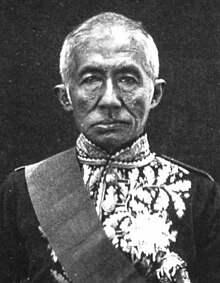
Back Mongkut AF راما الرابع Arabic راما الرابع ARZ রাজা মংকুট Bengali/Bangla Mongkut Catalan Rama IV Danish Mongkut German Mongkut EO Mongkut Spanish Mongkut EU
| |
|---|---|
| King Rama IV | |
 Portrait by John Thomson, c. 1865 | |
| King of Siam | |
| Reign | 2 April 1851 – 1 October 1868 |
| Coronation | 15 May 1851 |
| Predecessor | Nangklao (Rama III) |
| Successor | Chulalongkorn (Rama V) |
| Viceroy | Pinklao (1851–1866) |
| Born | 18 October 1804 Bangkok, Siam |
| Died | 1 October 1868 (aged 63) Bangkok, Siam |
| Spouse |
|
| Issue more... |
|
| House | Chakri dynasty |
| Father | Phutthaloetlanaphalai (Rama II) |
| Mother | Sri Suriyendra |
| Religion | Theravada Buddhism |
| Signature | |
Mongkut[a] (18 October 1804 – 1 October 1868) was the fourth king of Siam from the Chakri dynasty, titled Rama IV.[2] He reigned from 1851 until his death in 1868.
The reign of Mongkut was marked by significant modernization initiatives and diplomatic engagements, which played pivotal roles in shaping Thailand's trajectory towards progress and international relations. Siam first felt the pressure of Western expansionism during Mongkut's reign. Mongkut embraced Western innovations and initiated the modernization of his country, both in technology and culture—earning him the nickname "The Father of Science and Technology" in Siam.
Mongkut was also known for appointing his younger brother, Prince Chutamani, as Second King, crowned in 1851 as King Pinklao. Mongkut told the country that Pinklao should be respected with equal honor to himself (as King Naresuan had done with his brother Ekathotsarot in 1583). During Mongkut's reign, the power of the House of Bunnag reached its zenith: It became the most powerful noble family of Siam.
Mongkut is known in the West primarily through the lens of the 1951 musical The King and I and its 1956 film adaptation.
- ^ "In Remembrance of His Majesty King Mongkut (King Rama IV), 1 October – Assumption University of Thailand". www.au.edu. Retrieved 12 November 2023.
- ^ "The real 'King and I' – the story of new Thai king's famous ancestor". Reuters. 3 May 2019. Retrieved 12 November 2023.
Cite error: There are <ref group=lower-alpha> tags or {{efn}} templates on this page, but the references will not show without a {{reflist|group=lower-alpha}} template or {{notelist}} template (see the help page).